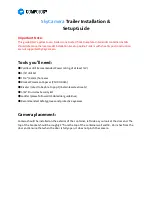
2
www.observint.com
8.
If the drop cable will route through a hole in the mounting surface, route the cable through the hole,
and then reassemble the camera on the mounting plate. Tighten the bezel only enough to hold the
assembly together, but do not tighten the bezel.
9.
Connect the camera drop cable to video and power extension cables.
10. Connect the CVBS leads to a toggle switch, if needed, or short them together for CVBS output at the
BNC connector. Seal the wires to protect from moisture.
11. Connect the other end of the video extension cable to a HD-TVI compatible (or CVBS, if configured)
video monitoring device, such as a HD-TVI digital video recorder (DVR).
NOTE
Drop cable connectors are not waterproof.
12. Connect the other end of the power extension cable to a 12 Vdc power source. Observe the polarity
of the cable shown in the photo on page 1 of this guide.
13. Rotate the camera module so that the light sensor is at the bottom of the IR array, if necessary.
14. While observing video from the camera on a monitor, aim the camera at your surveillance target.
See the figure below for adjustment ranges.
Cleaning
Clean the camera glass with an approved glass cleaning solution and a lint free cloth.
•
Dust can be removed from the unit by wiping it with a soft damp cloth. To remove stains, gently rub
the surface with a soft cloth moistened with a mild detergent solution, then rinse and dry it with a
soft cloth.
•
Remove all foreign particles, such as plastic or rubber materials, attached to the camera housing.
These may cause damage to the surface over time.
CAUTION
Do not use benzene, thinner or other chemical products on the camera assembly; these may
dissolve the paint and promote damage of the surfaces. Before using any chemical product,
carefully follow the accompanying instructions.
Troubleshooting
Problem
Possible Cause
Nothing appears on the screen
- Check the power connection.
- Check the video signal cable connection to the monitor.
The video image is dim or not clear.
- If the camera lens is dirty, clean it with a soft, clean cloth.
- Adjust the monitor controls, if necessary.
- If the camera is facing a very strong light, change the camera position.
The screen is dark.
- Adjust the contrast control of the monitor.
- Set the monitor impedance properly for the DVR (usually 75 Ω /Hi-Z),
and check the cable connections.
The camera is not working properly and the
surface of the camera is hot.
- Verify that the camera is correctly connected to an appropriate regulated
power source.
The image on the monitor flickers
- Make sure that the camera isn’t facing direct sunlight or fluorescent light.
If necessary,change the camera position.
Specifications
Camera
ALI-CD1720EC
Image Sensor
Progressive Scan CMOS
Effective Pixels
1280(H) * 720(V)
CVBS resolution
1000 TVL
Min. Illumination
0.01 lux @ (F1.2, AGC on), 0 lux with IR
Shutter Time
1/30 s to 1/50,000 s
Lens
3.6 mm Angle of View: 71°
Lens Mount
M12
Angle Adjustment
Pan: 0 ~ 360°, Tilt: 0 ~ 90°, Rotation: 0 ~ 360°
Day & Night
ICR
Synchronization
Internal synchronization
Video Frame Rate
720p @ 30 fps
HD Video Output
1 HD-TVI output or CVBS output
Enclosure color
White
General
Working Temperature/Humidity
-40 °F ~ 140 °F (-40 °C ~ 60 °C)
Humidity 90% or less (non-condensing)
Power Supply
12 Vdc
Power Consumption
Max. 4 W
Weather Proof Ratings
IP66
IR Range
Up to 65 ft (20 m)
Dimension
Φ3.52" × 2.75" (Φ89.5 × 69.8 mm)
Weight
0.57 lb (260 g)
© 2016 Observint Technologies. All rights reserved.




















